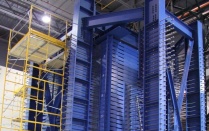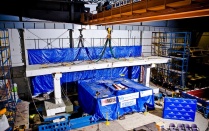
Pinar Okumus
PhD
Research Topics
Reinforced/Prestressed concrete highway bridges and buildings; Low-damage seismic systems
- Jung, M. J., Okumus, P., Frosch, R. (in press). “Evaluation of Torsional Strength Design Expressions Using Experimentally-Validated Numerical Analysis of Post-tensioned Girders.” Transportation Research Record.
- Sharma, S., Aaleti, S., Okumus, P. (in press). “A Novel Post-Tensioning Anchorage Solution with UHPC for Seismic Retrofit of non-ductile RC Walls.” ACI Structural Journal.
- Castillo, R., Okumus, P., Elhami-Khorasani, N., Chandola, V. (2025). “Shear Condition Classification of Cracked Reinforced Concrete Beams Using Machine Learning.” ASCE Journal of Bridge Engineering, Vol (30)7.
- Syed, M., Elhami-Khorasani, N., Okumus, P., Crocker, G. F., Ross, B. E., Kleiss, M. C. B. (2024). “Fragility Functions for Structural-Architectural Shear Walls with Interlocking Modules.” Sustainable and Resilient Infrastructure.
- Crocker, G. F., Ross, B. E., Kleiss, M. C, Okumus, P., Elhami Khorasani, N. (2024). “Cyclic Test of Precast Reinforced Concrete Tessellated Shear Wall.” ACI Structural Journal, Vol 121(5), pp. 37-50.
- Okumus, P., Basereh, S., Aaleti, S. (2024). “Lateral Load Response and Collapse Probability of Reinforced Concrete Shear Walls Retrofitted for Repairability.” Earthquake Engineering and Structural Dynamics, Vol 53(8), pp. 2577-2591.
- Castillo Perez, R. N., Elhami Khorasani, N., Okumus. P., Chandola, V. (2024). “Using Crack Width for Shear, Stiffness, and Stirrup Strain History Predictions for Reinforced Concrete Beams.” Structure and Infrastructure Engineering, pp. 1-13.
- Diaz Arancibia, M., Okumus, P. (2023), “Live Load and Long-Term Response of Steel Bridges with High Skew.” Engineering Structures, Vol 295, pp. 116811.
- Wang, H., Ranade, R., Okumus, P. (2023). “Calibrating a Physics-Based Corrosion Model with Field-Based Bridge Condition Data.” ASCE Journal of Bridge Engineering, Vol 28(5).
- Basereh, S., Okumus, P., Aaleti, S., Liu, Q. (2023). “Testing and Predicting the Response of Reinforced Concrete Shear Walls Retrofitted for Recentering.” Engineering Structures, Vol 291, pp. 116384.
- Sharma, S., Aaleti, S., Okumus, P. (2023). “Experimental Testing of RC Shear Wall Seismic Retrofit using Selective Weakening, Self-centering and Ultra High Performance Concrete.” Resilient Cities and Structures, Special Issue on Resilience of Structures to Earthquakes, Editors: Henry, R., Kurama, Y., Vol 2(1), pp. 76-90.
- Syed, M., Okumus, P., Elhami Khorasani, N., Ross, B. E., Kleiss, M. C. B. (2023). “Behavior and Modeling of Tessellated Shear Walls in a Structural Frame System.” Resilient Cities and Structures, Special Issue on Resilience of Structures to Earthquakes, Editors: Henry, R., Kurama, Y., Vol 2(1), pp. 152-161.
- Syed, M., Okumus, P. (2023) “Slender Reinforced Concrete Shear Walls with High-Strength Concrete Boundary Elements.” Frontiers of Structural and Civil Engineering, Vol 17, pp. 138-151.
- Bazrafshan, P., On, T., Basereh, S., Okumus, P., Ebrahimkhanlou, A. (2023). “A Graph‐based Method for Quantifying Crack Patterns on Reinforced Concrete Shear Walls.” Computer-Aided Civil and Infrastructure Engineering.
- Castillo Perez, R. N., Okumus, P., Elhami Khorasani, N., Chandola, V. (2022) “Prediction of the Ultimate Shear Strength of Reinforced-Concrete Beams Using Machine Learning Algorithms.” ACI Structural Journal.
- Wang, H., Ranade, R., Okumus, P. (2022) “Estimating Chloride Exposure of Reinforced Concrete Bridges Using Vehicle Spray and Splash Mechanisms.” Structure and Infrastructure Engineering.
- Elsayed, M. E. A., Fulmer Crocker, G., Ross, B., Okumus, P., Kleiss, M. C. B., Elhami Khorasani, N. (2022) “Finite Element Modeling of Tessellated Beams.” Journal of Building Engineering, Vol 46, pp. 103586.
- Wang, H., Ranade, R., Okumus, P. (2021) “Seismic Fragility of Reinforced Concrete Bridge Columns Utilizing Ductile Fiber-Reinforced Concrete Covers.” Structure and Infrastructure Engineering.
- Syed, M., Moeini, M., Okumus, P., Elhami Khorasani, N., Ross, B. E., Barrios Hernandez, C. (2021) “Analytical Study of Tessellated Structural-Architectural Reinforced Concrete Shear Walls.” Engineering Structures, Vol 244, pp. 112768.
- Yang, C., Okumus, P. (2021) “Numerical Investigation of High-strength Steel and Ultra-high-performance Concrete for Ductile Rectangular Hollow Columns.” ASCE Journal of Structural Engineering, Vol 147(7).
- Yang, C., Okumus, P. (2021). “Seismically Resilient Hybrid Precast Concrete Piers with Ultra-high-performance Concrete.” ASCE Journal of Bridge Engineering, Vol 26(6).
- Sharma, S., Ronanki, V.S., Aaleti, S., Okumus, P. (in press). “Experimental Investigation of Surface Preparation on Normal and Ultra High Performance Concrete Interface Behavior.” ASCE Journal of Bridge Engineering.
- Okumus, P., Diaz Arancibia, M. (2020) “Sources, Mitigation and Implications of Skew Related Concrete Deck Cracks in Girder Bridges.” Structure and Infrastructure Engineering.
- Kizilarslan, E., Okumus, P., Oliva, M.G. (2020) “Debonding Strands as an Anchorage Zone Crack Control Method for Pretensioned Concrete Bulb-tee Girders.” PCI Journal, Vol 65 (5), pp. 65-80.
- Ross, B, Yang, C., Barrios Hernandez, C., Okumus, P., Elhami Khorasani, N. (in press) “Tessellated Structural-Architectural Systems: A Concept for Efficient Construction, Repair, and Disassembly.” ASCE Journal of Architectural Engineering.
- Basereh, S., Okumus, P., Aaleti, S. (2020) “Reinforced Concrete Shear Walls Retrofitted Using Weakening and Self-Centering: Numerical Modeling.” ASCE Journal of Structural Engineering, Vol 146 (7).
- Diaz Arancibia, M., Rugar, L. S, Okumus, P. (in press) “Role of Skew on Bridge Performance.” Transportation Research Record: The Journal of the Transportation Research Board, 1-11.
- Yang, C., Okumus, P., Ren, R. GS (2019) “A Hysteretic Model for Self-centering Precast Concrete Piers with Varying Shear-slip between Segments.” Engineering Structures, Vol 188, pp. 350-361.
- Murray, C., Diaz Arancibia, M., Okumus, P., Floyd, R. (2019) “Destructive Testing and Computer Modeling of a Scale Prestressed Concrete I-girder Bridge.” Engineering Structures, Vol 183, pp. 195-205.
- Diaz-Arancibia, M., Okumus, P. (2018) “Load Testing of Highly Skewed Concrete Bridges. Download pdf” ACI Special Publication on Evaluation of Concrete Bridge Behavior through Load Testing - International Perspectives. SP323-2, 18.
- Yang, C., Okumus, P. (2017) “Mechanical Behavior and Prestress Loss of Unbonded Post-tension Strands in Self-centering Structures.” ASCE Journal of Materials in Civil Engineering, Vol 29(12), 0401724-1-14.
- Yang, C., and Okumus, P. (2017) "Ultra-High Performance Concrete for Post-tensioned Precast Bridge Piers for Seismic Resilience." ASCE Journal of Structural Engineering, 143 (12), 04017161-1-13.
- Warenycia, K., Diaz Arancibia, M., Okumus, P. (2017) “Effects of Confinement and Concrete Nonlinearity on Transfer Length of Prestress in Concrete.” Structures, Vol 11, pp. 11-21.
- Diaz Arancibia, M., Okumus. P. (2017) “Causes of Excessive Detensioning Stresses in Northeast Extreme Tee (NEXT) Beams.” PCI Journal, Vol 62(3), 31-45.
- Okumus, P., Kristam, R. P., Diaz-Arancibia, M.GS (2016), “Sources of Crack Growth in Pretensioned Concrete-Bridge Girder Anchorage Zones after Detensioning.” ASCE Journal of Bridge Engineering, Vol 21 (10), 04016072.
- Hoang, T.S, Ducharme, K.S, Kim, Y., Okumus, P. (2016). “Structural Impact Mitigation of Bridge Piers Using Tuned Mass Damper.” Engineering Structures, Vol 112, pp. 287-294.
- Lanssens, T., Tanghe, C., Rahbar, N., Okumus, P., Van Dessel, S., El-Korchi, T. (2014). “Mechanical Behavior of a Glass Fiber-Reinforced Polymer Sandwich Panel with Through-Thickness Fiber Insertions.” Construction and Building Materials, Vol 64, pp. 473-479.
- Okumus, P., Oliva, M.G., Hoehn T. (2015). “The Impact of Cast in Place Column Construction Vibration on Vibration Sensitive Facilities.” ASCE Journal of Practice Periodical on Structural Design and Construction, Vol 20 (1), 1-7.
- Okumus, P., Oliva, M.G. (2014). “Strand Debonding for Pretensioned Bridge Girders to Control End Cracks.” ACI Structural Journal, Vol 111(1), pp. 201-210.
- Okumus, P., Oliva, M.G. (2013). “Evaluation of Crack Control Methods for End Zone Cracking in Pretensioned Bridge Girder Ends. Download pdf” PCI Journal, Vol 58 (2), pp, 91-105.
- Okumus, P., Oliva, M.G., Becker S. (2012). “Nonlinear Finite Element Modeling of Cracking at Ends of Prestressed Bridge Girders.” Engineering Structures, Vol 40, pp. 267-275.









